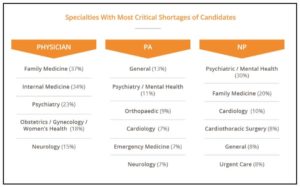Physician recruitment is getting more competitive with the demand for primary care and mental health specialists (in particular) outpacing supply.
A survey of nearly 200 healthcare employers by Health eCareers, found that 50% of respondents planned to hire more full-time healthcare professionals in 2018 versus 2017.
Over half of respondents indicated that salaries were trending slightly or significantly higher for both new hires and existing staff.

The time to fill an open position for a new physician remained unchanged from 2017 to 2018 at about 14.1 months, compared with 5.2 months for PAs and 5.4 months for NPs.
Doctors have a lot of choice
Since doctors have a lot of career options, it’s up to recruiting practices to determine not only what will appeal to them in the short term, but what will motivate them to stay over the long term.
One way that practices can do this is by clearly communicating what they have to offer on their website. This includes basic amenities (e.g., a competitive salary, benefits, and perks), but should go beyond this by listing broader benefits such as the opportunity to do research and contribute to a practice’s growth.
“Present day doctors are incredibly well-trained and they want to make sure they can help transform a medical practice,” explains Phillippa Ewing, Ashworth Creative’s lead Marketing Strategist. “Young doctors are at the start of their career and want to make sure that the practice is at the forefront of medicine. They’re looking towards the future of what a medical practice could be.”
Your practice website is your strongest recruiting tool
Millennial doctors do the bulk of their research online when looking for a new job. This new generation of physicians is much more comfortable online than their predecessors.
To this end, respondents in the Health eCareers survey indicated that healthcare industry websites were their most commonly used recruiting resource. Employer branding factors largely into successful recruiting, with respondents indicating that 80% of employer websites include some information about brand culture, but only 15% providing a comprehensive recruiting portal.
“Most recruits are introduced to a practice via word of mouth or from following an ad,” explains Phillippa. “Their first contact with a practice is very likely to be the practice’s website.”
Phillippa recommends including as much information as possible about the practice on its website. “Include list of equipment and services so it’s clear a practice is state-of-the art,” she explains. “Recruiters should be aware that this is the kind of thing new physicians are looking for, but don’t stop there. Make sure you list patient amenities that give the practice an advantage over competitors such as on-site radiology and pathology, extended hours, and more.”
Business incentives are key
Doctors know that they’re joining a business, so practices must communicate the ways that they are physician led, but patient centric. “Incoming physicians need assurance that they can have a positive effect on patient outcomes,” Phillippa explains, “But also how they can contribute to the practice’s bottom line. Doctors want to know they’re going to make a good living in the practice.”
One way that practices can communicate this is by listing all the accrediting organizations to demonstrate they’re nationally or regionally accredited for the work that they do. This highlights the credibility of the organization and communicates that the practice offers a financial model that will reward the doctor for their hard work.
Many physicians have something specific in mind which is focused on the kind of medicine they want to practice. They have the luxury of choice, so figuring out—and communicating—what will appeal to them should be a key goal for developing the right content.
The Health eCareers survey revealed that some of the top recruiting incentives that were being offered more frequently included sign-on bonuses, relocation assistance, CME allowances, and free medical insurance.

Recruiting physicians for positions they may not realize they’re a good fit for is a challenge. Practices can tackle this by addressing not only the nuts and bolts of a position, but the practice’s philosophy on things like work-life balance and career advancement.
Recruiting the right doctor
There is a huge opportunity for practices to stand out by featuring programs or benefits that combat physician burnout.
Nearly 80% of respondents in the Health eCareers survey indicated they hadn’t implemented any new programs or benefits in 2017 to address the issue of employee burnout, yet this is a key reason why healthcare professionals look to change employers.
“Doctors would actually like to live life,” Says Phillippa, “Finding a work-life balance is a key goal among young physicians and recruiting practices need to place tremendous emphasis on how they help their employees avoid burnout.”
Achieving fulfillment from their work while also living a balanced lifestyle is something that practices should emphasize to attract the right candidate. “Everybody is looking to make the right choice,” explains Phillippa, “So if you provide physicians with the opportunity to do research (for example), that should be clearly communicated.”
The nature of how patients seek healthcare is changing and this should be addressed as well.
“Millennials prefer urgent care,” says Phillippa, “And because many of the physicians that practices want to recruit will be millennials, it’s important to make the case about the benefits of primary care.”
Finding qualified candidates will likely continue to be a challenge for healthcare recruiters, but practices that present comprehensive content at every touchpoint are the ones that will stand out to job seekers.


